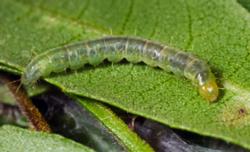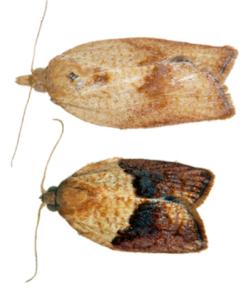Spring 2010: Light brown apple moth: Now what happens to IPM?
Regional Report for Santa Cruz and Monterey Counties by Steve Tjosvold
Light brown apple moth (LBAM) is a new invasive moth species that has been detected in 16 counties in California and is widely distributed in the landscape and wild areas in the Monterey Bay Area. It has been found on many ornamentals and on some fruit hosts. LBAM is a quarantined pest and must be destroyed if found in a commercial nursery. Usually broad- spectrum chemicals are applied over the entire infested nursery to eradicate LBAM. So, what happens to the IPM programs in these infested nurseries?
Scouting is the foundation that supports a strong IPM program. It helps find, identify and quantify disease, pest and weed populations so a grower can make intelligent pest management decisions. Usually a few pests and the minor damage they cause can be tolerated on most crops for short periods; these pests can be left for natural biological control or environmental control mechanisms. With scouting, the manager can decide when populations are heading toward levels that are not tolerable, and control strategies can be implemented. Predators and parasites can be introduced into nursery stock early enough to be effective or more specific, and less toxic insecticides can be applied when most appropriate and effective.

Usually with an invasive pest, however, the pest cannot be tolerated. If a regulatory inspector finds LBAM -- just one specimen -- it often means that all the nursery stock or the entire crop is quarantined and a specified regulatory insecticide treatment is typically applied to plants in the entire nursery. Many growers choose to use sprays that kill eggs and larvae, which usually minimizes the time that sales are placed on hold by officials. These sprays often have a broad spectrum of activity, and can kill natural or introduced parasitoids and predators that a grower is trying to maintain. This sacrifice might make sense if LBAM is actually eradicated, but the control strategy falls short for many Monterey Bay nurseries when they are surrounded by native or landscape hosts with LBAM. In these cases, moths can readily migrate back into the nursery, and the process starts all over again, jeopardizing the natural and introduced parasatoids and predators.
Growers that have established scouting programs with trained in-house personnel find that the transition to intensive scouting for LBAM becomes much easier. With some refinement of established practices and targeting for LBAM larvae or any look-alike leafrollers, these programs can be effective in finding and killing LBAM.

Regulatory officials are considering allowing a targeted insecticide application to the areas where LBAM life stages have been found. This “localized” application would be made instead of a mandatory insecticide treatment to the entire nursery. This targeted application would be triggered by an official regulatory detection, and would require that the nursery operator have an active and demonstrably successful IPM program, including scouting, in place to control leafrollers (any leafroller). The advantage of this concept is that it uses inspectors and grower- scouts to make smart and targeted treatments to areas most likely to contain LBAM. This would leave large pockets of beneficial insects that could help fight LBAM or other leafrollers if they are re-introduced. The cost to the environment and the grower’s eradication costs could be significantly less than blanket pesticide applications. Follow-up regulatory inspections would determine if the treatments were effective before any plants would be shipped or sold.












